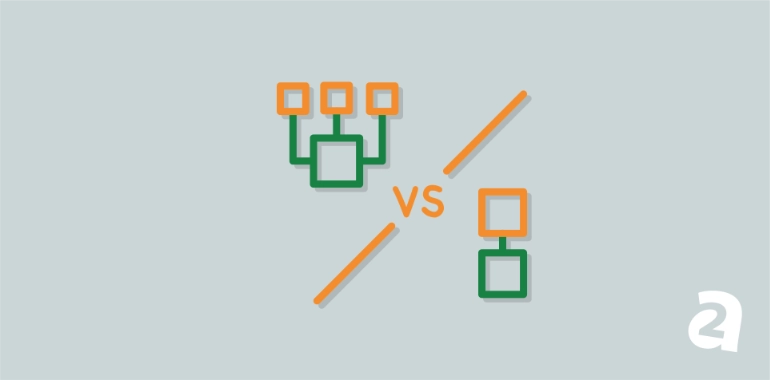Can Your Website Handle Heavy Traffic?
Getting heavy traffic is every website owner’s dream. However, if your site isn’t equipped to handle large volumes of traffic, this dream can quickly turn into a nightmare. Your website may grind to a halt or even crash, at the exact moment when it has more eyes on it than ever before.
By taking some simple steps now, you can ensure there’s no such thing as too much traffic. There are many ways to prepare your website for record-breaking virtual footfall. As an added bonus, many of these techniques will improve your website’s performance, even when you aren’t experiencing a surge in visitors.
In this article, we’ll explore why heavy traffic can damage your website. We’ll then help you provide the best possible visitor experience, even during periods of high traffic!
How High Traffic Can Hurt An Unprepared Website
A “high volume of traffic” can be a tricky thing to quantify. It may help to use analytics platforms such as Google Analytics to establish a baseline for your website, and track trends in your traffic over time.
A high volume of traffic is an unexpected spike that’s significantly higher than your baseline, and deviates from the expected trend. In terms of numbers, this might be a relatively small increase, or it could be thousands of extra visitors.
Basically, if you receive more hits than you were expecting, this is a high volume of traffic for your particular website. This kind of heavy traffic increases the burden on your site’s servers. Depending on your servers, they may struggle to process so many requests simultaneously. This can have a negative impact on your site’s loading times.
Suddenly, there are more people on your website than ever before, and they’re all having a bad experience. This can affect your key metrics, including the time spent on your website, the number of pages visited, and conversions. All of these are search engine ranking factors. If your site isn’t prepared to handle a spike in popularity, a short-term increase in traffic could cause long-term damage to your Search Engine Optimization (SEO).
High traffic can also have an immediate impact on the user’s experience. People visiting your site for the first time may conclude that your website is slow and buggy. Long-term readers may also become frustrated by the drop in performance, and defect to your biggest competitors.
If your servers cannot keep up with the volume, your website may even crash. Instead of capitalizing on the increased traffic, you’re now getting less conversions than you’d expect on a typical day.
Explaining the ‘Reddit Hug of Death’
There are many reasons why your website may experience a surge in traffic. For example, your latest marketing campaign or promotion may attract more attention than you were anticipating. Your social media posts may be retweeted by someone with a large online following, or your latest blog post may even go viral.
This is an opportunity to capture an entirely new audience and earn more conversions. However, many websites have buckled under this kind of pressure – to the point where there’s even a name for this phenomenon.
The Reddit Hug of Death, also known as the ‘Slashdot Effect’, occurs when a popular website links to a smaller site. This results in a large and sudden influx of visitors. Developer Craig Junghandel reported a 4,500 percent increase in traffic after being featured on Reddit.
While this sounds like a dream for any website owner, many websites struggle to survive the Reddit Hug of Death. CodinGame’s platform experienced two hours of downtime after being featured on the front page of Reddit, while Craig Junghandel’s website was down for nearly five hours.
Downtime is always bad news, but an unexpected upsurge in traffic can be particularly dangerous if you don’t have automated uptime monitoring in place. Your website could potentially be offline for an extended period of time before you even realize that something is wrong.
A dramatic increase in traffic may even exceed your bandwidth allowance. Depending on your hosting plan, this may result in additional charges. You may even need to upgrade your hosting plan, in order to cope with the increased demand.
An increase in traffic should be a positive experience, rather than an ordeal. Thankfully, there are ways to prepare your website for the unexpected.
Why It’s Important to Track Your Traffic
If you’re going to prepare for heavy traffic, it helps to understand what “heavy traffic” means for your particular website. Here, it can help to record the average traffic your website receives. You can also monitor how well your site is handling this level of traffic.
Once you have this information, you’ll be in a better position to judge what constitutes heavy traffic for your particular website. You’ll also be able to predict the point where your site might start to buckle under rising visitor numbers.
There are various tools you can use to analyze your traffic – Google Analytics is a popular and free option. After logging into your Google Analytics account, you’ll be directed to the service’s Overview screen. Your site’s overall traffic will appear there as Sessions.
There are also various tools that can monitor your site’s performance. Popular choices include Google PageSpeed Insights, Pingdom by SolarWinds, and GTmetrix.
Whatever web performance analytics tool you choose, we recommend re-running its tests after implementing each of the tips in the next section. This will help you gauge how the changes affect your website.
You can also use these tools to set up alerts. In particular, we’d recommend monitoring your website for downtime, using a tool such as Pingdom. If your website does experience downtime as a result of high levels of traffic, you’ll want to know about it immediately. This is essential for resolving the issue and getting your website back online, as quickly as possible.
How to Prepare Your Site for Heavy Traffic (7 Ways)
Whether you’re planning a big promotional campaign, or you just want to ensure your site is crash-proof, it’s important to plan for success. Let’s look at seven ways that you can prepare your website for heavy traffic.
1. Choose the Right Hosting Plan
To ensure your site can handle heavy traffic, it’s vital you choose the right provider and hosting plan. New businesses typically have tighter budgets, which means their main motivation is finding an affordable plan. For this reason, shared hosting is a popular choice for many startups and smaller businesses.
However, as a shared hosting customer you share the server resources with other websites. If your site has a steady amount of traffic, shared hosting may meet all your website’s needs. However, if your site experiences a surge in traffic, you may struggle to access the resources you need to handle this increased demand.
To help our customers strike a balance between affordability and managing fluctuating traffic, we offer Virtual Private Servers (VPS). Unlike shared hosting, a VPS is partitioned. This means you have exclusive access to a portion of resources, including bandwidth and memory.
Ideally, you should also have the option to upgrade your plan temporarily. These extra resources can help you seamlessly scale to support an unexpected influx of traffic. At A2 hosting we offer a Performance Plus service for our Turbo Boost and Turbo Max plans. This adds an extra gigabyte of memory to your plan, and doubles your processing power.
To activate Power Plus, just log into your A2 Hosting control panel, and create a support ticket. A member of our team will be in touch to discuss adding this powerful and flexible option to your hosting account.
In addition, if your WordPress environment is stable, it’s less likely to crash, even under heavy server demand. To provide this environment, your plan should support the latest versions of all the technologies you want to use. For example at A2 Hosting we support PHP 7.4, plus MariaDB and MySQL 5.6.
2. Manage Your WordPress Comments
If a page or post goes viral, it can result in an influx of comments. Engagement is great for SEO, but a busy comments section can add significant load to your server. Tests suggest that even 18 comments can have an impact on page loading times.
You can offset this increased load, by optimizing the performance of your comments section. This helps the server process a large number of comments more effectively, and serve your content to visitors as quickly as possible.
There are several ways to optimize your comments section. This includes using a comment management plugin, such as wpDiscuz or GraphComment. Alternatively, you can use a third party commenting platform, such as Disqus or Facebook Comments.
By default, WordPress will load all your comments with the initial page load. For pages with hundreds or even thousands of comments, this can noticeably increase page load speeds.
If you stick with WordPress’ native commenting system, you might want to limit the number of comments displayed on initial page load. To set this limit, navigate to Settings > Discussion in the WordPress dashboard.
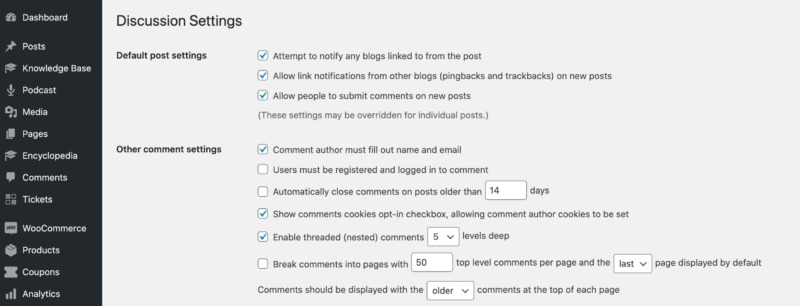
You can then select the following checkbox: Break comments into pages with. Next, specify the number of comments that you want to display with the initial page load.
Since comments add to the server load, all comments should add value. Hopefully, you’re already using a plugin to block spam comments. However, you can also lessen the load by deleting inappropriate comments, comments that are no longer relevant, or even spam that has slipped through your filters. You can bulk delete comments, using the phpMyAdmin administration tool.
3. Consider Using a Caching Plugin
In a nutshell, caching creates static HTML versions of your website’s content. This reduces the number of times WordPress has to request your content, which can help your site manage heavy traffic.
There are plenty of caching plugins available for WordPress, including W3 Total Cache. This popular plugin offers built-in browser caching, plus script minifying for your HTML, JavaScript, and CSS.
If you’re an A2 Hosting user, you don’t need to worry about installing and configuring a separate caching system. All our A2 Hosting customers have access to the A2 Optimized WP plugin, which is based on W3 Total Cache.
The A2 Optimized plugin provides custom caching settings and functionality, including the Memcached distributed memory object caching system. Memcached accelerates page load times by caching frequently accessed data in Random-Access Memory (RAM). This includes the results of database calls, and Application Programming Interface (API) calls.
The A2 Optimize plugin also provides TurboCache. Instead of running each page’s scripts and database queries, TurboCache stores a static copy of the page’s HTML output. The server will then use this cached copy to serve subsequent page requests.
You can install the A2 Optimized plugin by logging into your A2 dashboard, then selecting cPanel Login.
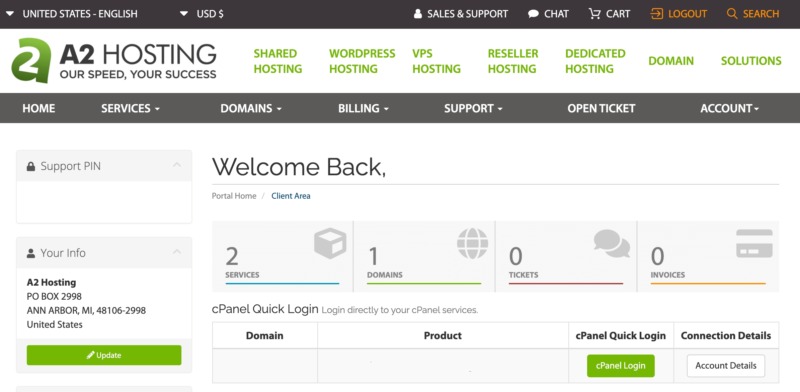
You can then find the Softaculous Apps Installer section. Select WordPress A2 Optimized, and follow the onscreen instructions to install.
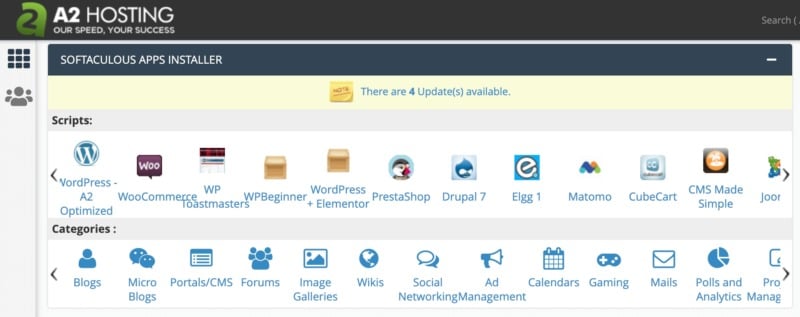
The A2 Optimized plugin supports different optimization settings based on the web applications you’ve installed on your website. For WordPress, this includes CSS, HTML, and JavaScript minification.
4. Reduce Load Times With a Content Delivery Network
When you host your website, you typically choose a physical data centre location. For example, your website may be physically located on a host server in New York. When data has to travel long distances, it can cause latency. If your host server is located in New York, those accessing your site from the UK will typically experience longer loading times compared to someone in Boston.
A Content Delivery Network (CDN) can reduce the load on your server during times of high (and low) traffic. It can also boost your website’s overall performance. This means even if your site does start to struggle under pressure, it should still provide a higher level of performance compared to sites not using a CDN.
A CDN is a network of servers located around the world. These servers, sometimes referred to as Points Of Presence (POPs) are designed to host and deliver copies of your website’s static content. This includes images, videos, CSS, and JavaScript.
When someone visits your site, a CDN can detect the origin of the request using geolocation routing. The CDN will then route these requests to the nearest POP, and load your content from a server that’s physically closer to the user’s location. This reduces the distance your data has to travel, which reduces latency. Research suggests that a CDN can improve your website’s loading times by 38.24 percent.
There are plenty of CDNs available for WordPress. However, we’ve previously compared three popular CDNs you may want to use with your WordPress website.
5. Disable or Locally-Host Visitor Avatars
WordPress comes with built-in support for Gravatar. This means that anyone with a Gravatar account is automatically assigned an avatar whenever they comment on your site.
This is great for adding a personalized touch to your comments section, while also encouraging visitor engagement.
However, each Gravatar requires an HTTP request. A busy comments section may mean the server has to request hundreds or even thousands of Gravatars. This can add a considerable load to your server, and impact page loading speeds.
You can reduce the load on your server by disabling avatars. This can be particularly useful if your site regularly attracts a large volume of comments.
To remove avatars from your comments section, navigate to Settings > Discussion. You can then scroll to the Avatar Display section.
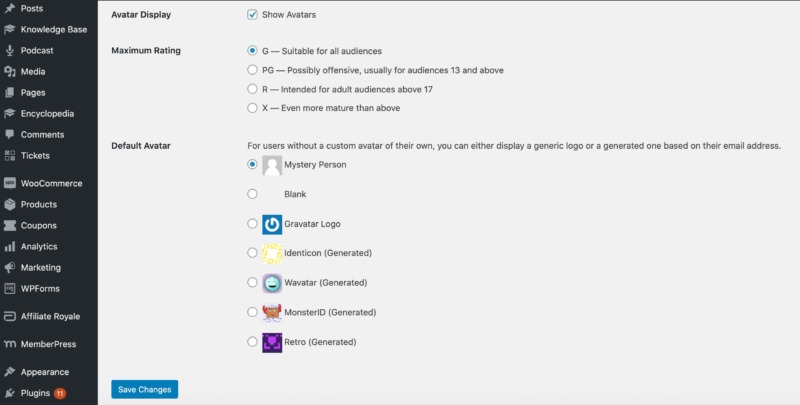
Now, deselect the Show Avatars checkbox. Alternatively, you can switch to locally-hosted avatars using a plugin such as WP User Avatar. After activating this plugin, make sure you navigate to Avatars > Settings.
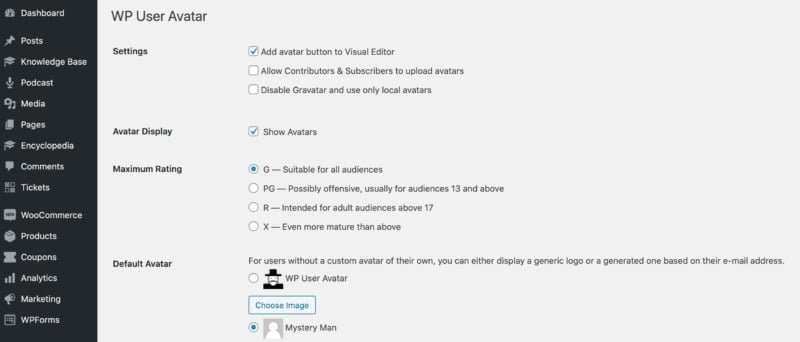
You can then select the following checkbox: Disable Gravatar and use only local avatars. If you don’t want to disable avatars or switch to locally-hosted avatars, you can also load your Gravatars using a CDN.
6. Be Critical About Plugins and Themes
A lean website will load more quickly, even during times of high traffic. The huge community of themes and plugins is one of WordPress’ greatest strengths. However, poorly designed and maintained themes and plugins can bloat your website with unnecessary code. This can degrade your website’s performance, and make it more difficult to handle large volumes of traffic.
Some themes also ship with multiple bundled plugins. The more popular those themes become, the more updates they get, which ultimately translates to a bigger, more complex codebase. This can result in poor performance.
To keep your site running smoothly even during times of high traffic, you can opt for a fast WordPress theme. You should also only install plugins from reputable sources, such as the official WordPress repository or CodeCanyon.
It’s also a smart idea to research plugins before installing them. This includes examining recent reviews, and the date when the plugin was last updated. If the plugin has positive, recent reviews and is regularly updated, the plugin is less likely to impact your website’s performance.
7. Perform Regular Content Audits
Even with your best efforts, exceptionally high volumes of traffic may still result in increased loading times in some scenarios. Once your site loads, you’ll want to provide visitors with a seamless experience, in order to combat any negative impressions they have of your website.
To ensure you’re providing the best possible experience, it’s a smart idea to perform regular content audits. By examining your website’s content, you can often identify smaller issues that may impact the visitor experience, including broken links.
While performing your content audit, you can also look for opportunities to make your content more engaging. A slow website is always going to work against you, but quality content can contribute positively towards key metrics such as bounce rate, and time spent on your website.
As part of your content audit, you might re-write headlines to make them more compelling. You can also update outdated facts and statistics, to give older content a new lease of life.
While performing your content audit, you can also identify your best-performing and worst-performing posts, and use this information to influence your content calendar. By populating your site with engaging, quality content, you can maximize your chances of engaging visitors, even when your server is noticeably struggling under the load.
Conclusion
Heavy traffic is a sign of online success. However, if you’re not prepared for a high number of visitors, you’ll struggle to capitalize on this success. Your website may grind to a halt, or even buckle under the weight.
Thankfully, with the right preparations your WordPress website can handle large volumes of traffic. For the best results, we’d recommend opting for a caching solution, which could be a third party WordPress plugin or a system provided by your WordPress host. You can also reduce the load on your server with a Content Delivery Network (CDN), or by disabling visitor Gravatars.
Your hosting provider can also play a significant role in helping you manage large volumes of traffic. For the best results, we recommend a flexible hosting provider, that offers a range of plans, and gives you the option to temporarily upgrade during times of high traffic.



